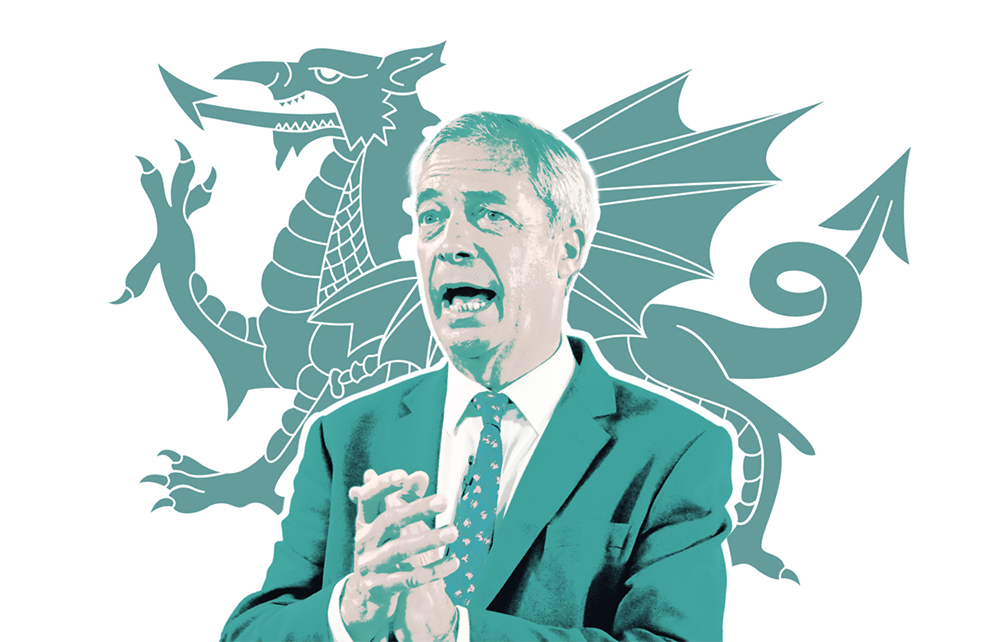A spectre is haunting Wales. Fresh from Reform’s election victories in Westminster, Nigel Farage is turning his attention westwards, to Cardiff Bay. He wants Reform to replace the Tories there as the main challenge to Labour in May 2026, creating a major platform for his party ahead of the 2029 general election.
The man plotting the Tories’ downfall in Wales is someone who knows their leader well. Oliver Lewis, Reform’s chief spokesman, worked with Kemi Badenoch at Coutts. ‘She was very aware of the importance of fulfilling duties she felt were important to her,’ he says, carefully, when we speak. To beat his ‘reasonably competent’ old colleague, Lewis stresses an ‘open-minded’ approach to devolution and a simple message of change after a century of Welsh Labour hegemony. If the plan works in Wales, it could serve as a blueprint for elsewhere in the UK.
Reform’s hopes for 2026 are based on three constitutional novelties. The first is an expanded Senedd, from 60 members to 96, which lessens the natural advantage of any incumbency. The second is D’Hondt voting – a new proportional system that favours smaller parties. ‘It’s what the European parliament used,’ says one Reform aide. ‘We all know what that did for Farage-led political parties.’ The third is the expansion of the vote to 16- and 17-year-olds. Reform is expected to do well among first-time voters. Many Gen Z-ers regard Farage as a celebrity figure.
Reform certainly seems to be pushing at an open door. In July, the party came within 17,000 votes of relegating the Welsh Tories to third place for the first general election since 1931. Reform beat the Conservatives in 17 of the 32 parliamentary constituencies and finished second behind Labour in 13. Some of these were in areas which have returned Labour MPs for 100 years, including next door to Nye Bevan’s old seat.
‘Hordes of our voters would never vote Conservative with a barge pole,’ says Lewis. Reform, he believes, offers ‘the best of left and right’ in that ‘some of our ideas are considerably left-wing – far to the left of what Labour has advocated for, particularly in the case of nationalisation and with our policy support of the steel industry’. The party’s colours are worn by an expanding band of converts, with 4,000 members assembled in 16 branches, based on the new Senedd regions.
The Welsh Tories, by contrast, are depleted and demoralised. Of their 2024 voters, four in ten will be dead by 2029; less than a tenth are under 65. The Tories lost every Westminster seat in July and now have barely a hundred councillors across Wales. Membership is believed to be less than 5,000. ‘Everyone knows everyone in the Welsh Tories,’ remarks one unsuccessful candidate. ‘But now there’s fewer of them to know.’ Lewis cites his own seat in Powys where ‘plenty of the former branch officers have come over to Reform’. High-profile defections are expected at London press conferences too.
‘Everyone knows everyone
in the Welsh Tories. But now there’s fewer of them to know’
There are many anecdotal tales of support switching. A former Tory MP was surprised to see stalwarts of her local branch lining up at a recent Reform rally. Another nominee discovered in the middle of the election that a local Tory patron had signed the nomination papers of a candidate for Abolish, Wales’s anti-devolution party. ‘Hotbeds of Reform’ is how another describes his association. ‘Old, stuffy, grey,’ is the verdict of a third.
Sixteen Tories sit in the Senedd. All have places in the ‘shadow cabinet’ under leader Andrew R.T. Davies. Team meetings are described as a ‘fudge factory’ by one attendee who recalls a discussion on a ‘knife-edge’ vote about whether to support free school meals. The Tories eventually did support it, but only after nearly an hour’s debate. ‘Comfortable in opposition,’ complains one MS, who says Davies’s main aim is to remain second in the Senedd. ‘I’ve never heard Andrew say he wants to be first minister.’
Davies’s defenders say he faces an uphill battle against the centre-left elite they call the ‘Cardiff Bay bubble’. This is populated by the ‘Taffia’ – the Welsh-speaking soft nationalists who dominate the political and media ecosystem. Tory supporters admire Davies’s attacks on ‘woke’ initiatives, such as ‘anti-racist’ dog-free zones. They argue that under the new PR system, being just ‘anti-Labour’ will no longer be enough. Yet Davies’s comments often provoke complaints from Senedd moderates. The party oscillates between devolution-scepticism and enthusiasm to retain their core support of self-identifying ‘British’ voters in Wales. It is a strategic ambiguity which risks being blown apart by the simple certainties offered by Reform.
The coming months will be dominated by selection battles as defenestrated MPs slug it out with Senedd colleagues for prize spots on the new list system. Likely transfers from Westminster include Sarah Atherton and Virginia Crosbie. Davies is hamstrung by the existing tripartite system, merely one of three voices who speak for Wales, alongside the Welsh chairman and shadow Welsh secretary. Farage and his ‘start-up party’, by contrast, ‘can impose candidates at will’, reflects an admiring Tory.

Within Welsh Labour, there is a sense of unease at the prospect of Reform replacing the known quantity of the Conservatives as its main rival. Keir Starmer’s strongholds are the same as they were for Ramsay MacDonald in 1924: the industrial heartlands of the northeast and southern valleys. In places such as the Rhondda, the name of Margaret Thatcher remains despised; some still resent £5 notes with Winston Churchill’s face on, more than a century after Tonypandy. Might a new party be best placed to peel off disaffected Labour voters?
Reform’s appeal will certainly resonate with those disappointed by Labour’s 25 years running Cardiff. Farage’s focus for the next six months is on county councils in England. After May, attention switches to Wales and Scotland. More than a quarter of the old Labour valleys say they’ll back Farage, according to Savanta. Other polls point to Reform winning 20 seats in Wales. The Senedd could then serve the role that Brussels did for Ukip – a useful source of funds and an established political base for Westminster.
For Labour and the Tories, the Senedd elections will carry a warning for 2029. For Starmer, it is the risk Reform poses in Labour’s deindustrialised heartlands. For Badenoch, it is how an ageing party gets run down in the middle of the road.
The Senedd building is designed to look as though it rises out of Cardiff Bay, symbolising the seamless flow between electors and the elected. A sea change looks likely – one in which the old order is swept away.








Comments